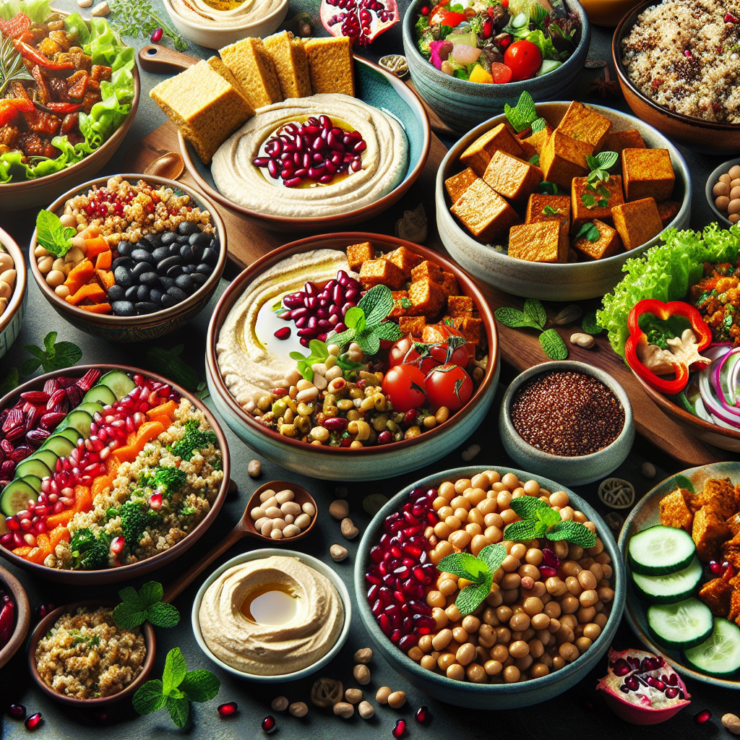The Plant-Based Phenomenon
Exploring the emergent trends in nutrition, the shift toward plant-based eating has gained significant momentum. This movement is marked by individuals opting for diets rich in vegetables, fruits, grains, nuts, and seeds, while reducing or eliminating animal products.
The Rise of Plant-Based Eating
Plant-based eating has seen a surge in popularity for various reasons. Health concerns, environmental impact, and ethical considerations regarding animal welfare are primary motivators for this dietary shift. Research indicates a growing percentage of the population is embracing plant-based meals at least part of the time, signaling a shift in mainstream dietary habits towards more sustainable and compassionate choices.
Benefits of a Plant-Based Diet
Adopting a plant-based diet comes with a multitude of benefits, both personal and global. Here are some key advantages:
-
Health: Studies have shown that plant-based diets are associated with a lower risk of heart disease, type 2 diabetes, hypertension, certain types of cancer, and obesity. The high intake of fiber, vitamins, and phytonutrients found in plants contributes to overall well-being and can lead to increased longevity.
-
Environmental: A diet centered around plants is less taxing on the environment. It requires less water and land, and it produces fewer greenhouse gases compared to diets high in animal products.
-
Ethical: Many individuals choose plant-based diets out of concern for animal welfare, as it reduces the demand for animal farming, which is often criticized for inhumane practices.
| Benefits | Description |
|---|---|
| Health | Lower risk of chronic diseases, enhanced nutrient intake |
| Environmental | Reduced carbon footprint, less resource-intensive |
| Ethical | Decreased support for inhumane animal agriculture practices |
As awareness grows, so does the availability of high-protein vegan dishes that cater to the nutritional needs and busy lifestyles of those opting for plant-based eating. These dishes are designed to be not only nutritious and environmentally friendly but also quick and simple to prepare, ensuring that a sustainable diet is accessible to everyone.
Protein in a Vegan Diet
Protein is a vital macronutrient important for the body’s structure, function, and regulation of tissues and organs. In the context of a vegan diet, where traditional sources of protein such as meat, dairy, and eggs are absent, it becomes essential to find alternative sources to meet the body’s protein requirements.
The Importance of Protein
Protein plays a critical role in building muscle, repairing tissues, and producing enzymes and hormones. It also contributes to satiety, helping individuals feel full and satisfied after meals, which can aid in maintaining a healthy weight. For those on a plant-based diet, ensuring adequate protein intake is crucial for overall health and well-being.
Protein Sources in a Plant-Based Diet
A diverse range of plant-based ingredients provide ample protein for vegan diets. These ingredients not only offer protein but are also rich in other nutrients, contributing to a well-rounded diet.
| Protein Source | Protein Content (per 100g) |
|---|---|
| Lentils | 9g |
| Chickpeas | 19g |
| Black Beans | 21g |
| Tofu | 8g |
| Tempeh | 19g |
| Quinoa | 4.4g |
| Almonds | 21g |
| Chia Seeds | 17g |
| Hemp Seeds | 31g |
| Spirulina | 57g |
Incorporating these protein-rich foods into meals is an effective way to ensure adequate protein intake. From legumes like lentils and chickpeas to seeds such as chia and hemp, the options are plentiful and versatile. Whole grains like quinoa also contribute protein while providing complex carbohydrates for energy. Tofu and tempeh, made from soybeans, offer a complete protein source, containing all nine essential amino acids.
Understanding the protein content of various plant-based ingredients enables individuals to create high-protein vegan dishes that are not only nutritious but also align with sustainable eating practices. With the right knowledge and a variety of protein sources, maintaining a high-protein vegan diet can be both simple and delicious.
Crafting High-Protein Vegan Dishes
Creating high-protein vegan dishes can be a delightful and nutritious way to maintain a plant-based diet. This part of the guide focuses on selecting key ingredients that are rich in protein and balancing macronutrients to ensure a well-rounded meal.
Key Ingredients for High-Protein Meals
For those following a vegan diet, incorporating a variety of protein sources is essential. The following table lists some key ingredients that are not only high in protein but also versatile for cooking a range of dishes:
| Ingredient | Protein (per 100g) |
|---|---|
| Lentils | 9g |
| Chickpeas | 19g |
| Black Beans | 21g |
| Tofu | 8g |
| Tempeh | 19g |
| Quinoa | 4g |
| Almonds | 21g |
| Chia Seeds | 17g |
| Seitan | 75g |
| Nutritional Yeast | 50g |
These ingredients can be the foundation for numerous high-protein vegan dishes. For instance, lentils can be used in soups and stews, chickpeas in curries and salads, and tofu can be marinated and stir-fried. The versatility of these ingredients allows for creativity in the kitchen while meeting protein needs.
Balancing Macronutrients
While protein is a focal point in these dishes, it’s important to balance other macronutrients, including carbohydrates and fats, to create well-rounded meals. A balanced macronutrient profile supports overall health and ensures sustained energy levels throughout the day.
Here’s a simple guide to balancing macronutrients in vegan dishes:
- Protein: Aim to include a high-protein vegan ingredient as the centerpiece of the meal.
- Carbohydrates: Opt for complex carbs such as whole grains, sweet potatoes, and brown rice for added fiber and nutrients.
- Fats: Include healthy fats from sources like avocados, nuts, and seeds to enhance flavor and nutrient absorption.
Crafting high-protein vegan dishes involves selecting the right ingredients and ensuring that each meal is balanced with an array of macronutrients. Experimenting with different combinations of these ingredients can lead to delicious and satisfying meals that support a plant-based lifestyle.
Quick and Easy High-Protein Vegan Recipes
For individuals embracing a plant-based lifestyle, incorporating high-protein vegan dishes into their diet is essential. These recipes are designed to be both quick and easy, ensuring that one can maintain their dietary choices without compromising on nutrition or taste.
Breakfast Options to Start Your Day
Breakfast is the meal that sets the tone for the day. High-protein vegan options provide the energy needed to kickstart the morning.
- Tofu Scramble with Spinach: A scramble made from tofu, offering a high-protein alternative to eggs, mixed with nutrient-rich spinach.
- Chickpea Pancakes: Pancakes prepared with chickpea flour, packed with protein and a savory twist on the traditional breakfast.
- Peanut Butter and Banana Oatmeal: Oats topped with sliced banana and a generous dollop of peanut butter for a protein boost.
| Recipe | Protein (g) per serving |
|---|---|
| Tofu Scramble with Spinach | 20g |
| Chickpea Pancakes | 15g |
| Peanut Butter and Banana Oatmeal | 12g |
Protein-Packed Lunches for Sustained Energy
Lunch should provide sustained energy throughout the afternoon. These high-protein vegan dishes are perfect for a midday meal that won’t slow one down.
- Quinoa Salad with Black Beans: A refreshing salad with quinoa and black beans as the protein heroes, accompanied by a variety of vegetables.
- Lentil Soup: Hearty lentil soup that’s both warming and satisfying, offering a significant protein punch.
- Tempeh and Avocado Wrap: A wholesome wrap filled with protein-rich tempeh and creamy avocado for a filling lunch option.
| Recipe | Protein (g) per serving |
|---|---|
| Quinoa Salad with Black Beans | 18g |
| Lentil Soup | 14g |
| Tempeh and Avocado Wrap | 20g |
Nutrient-Dense Dinners for Evening Satisfaction
Dinner is the time to relax and enjoy a nutrient-dense meal to end the day. These high-protein vegan dishes are perfect for an evening meal that is both satisfying and wholesome.
- Stuffed Bell Peppers with Lentils and Rice: Bell peppers filled with a mixture of lentils and rice, baked to perfection.
- Vegan Chickpea Curry: A creamy curry made with chickpeas and coconut milk, served over brown rice or quinoa.
- Baked Tofu with Steamed Vegetables: Marinated tofu baked until crispy, paired with a side of steamed seasonal vegetables.
| Recipe | Protein (g) per serving |
|---|---|
| Stuffed Bell Peppers with Lentils and Rice | 19g |
| Vegan Chickpea Curry | 16g |
| Baked Tofu with Steamed Vegetables | 21g |
Incorporating these high-protein vegan dishes into one’s diet can be a simple and effective way to ensure adequate protein intake while enjoying delicious and diverse flavors. Whether for breakfast, lunch, or dinner, these recipes provide the nutrition needed to support a healthy and active lifestyle on a plant-based diet.
Tips for High-Protein Vegan Cooking
Crafting high-protein vegan dishes that are both nutritious and flavorful can be a straightforward and enjoyable process. With the right approach to flavor pairings, cooking techniques, and meal prepping, anyone can create delicious, protein-rich vegan meals.
Flavor Pairings and Seasoning
A key element of delicious high-protein vegan cooking is the use of herbs, spices, and other flavorings. They enhance the natural taste of plant-based proteins and can transform simple ingredients into exciting dishes.
| Ingredient | Seasoning Suggestions |
|---|---|
| Lentils | Cumin, Coriander, Garlic |
| Tofu | Soy Sauce, Ginger, Sesame Oil |
| Chickpeas | Paprika, Turmeric, Lemon Juice |
| Quinoa | Basil, Lemon Zest, Olive Oil |
| Tempeh | Smoked Paprika, Maple Syrup, Liquid Smoke |
By experimenting with these flavor pairings, one can achieve a variety of tastes that complement the primary protein source in a dish, ensuring that your meals are always interesting and appetizing.
Cooking Techniques to Preserve Nutrients
The cooking method chosen can significantly impact the nutritional content of vegan dishes. To preserve the most nutrients, it’s best to use methods that require minimal water and shorter cooking times.
| Protein Source | Recommended Cooking Technique |
|---|---|
| Beans and Legumes | Steaming, Pressure Cooking |
| Vegetables | Stir-frying, Steaming |
| Nuts and Seeds | Toasting, Soaking |
| Whole Grains | Boiling, Steaming |
By utilizing these cooking techniques, one can help retain the essential proteins and micronutrients in their ingredients, ensuring that the dishes are not only high in protein but also rich in other vital nutrients.
Meal Prepping for the Week
Meal prepping is an efficient way to ensure that high-protein vegan dishes are readily available throughout the week. By dedicating a few hours to preparing meals ahead of time, one can save time and reduce the temptation to opt for less nutritious options.
| Day | Meal Type | Protein Source | Additional Ingredients |
|---|---|---|---|
| Monday | Lunch | Quinoa Salad | Mixed Greens, Cherry Tomatoes, Cucumbers |
| Wednesday | Dinner | Lentil Soup | Carrots, Celery, Tomatoes |
| Friday | Breakfast | Tofu Scramble | Bell Peppers, Onions, Spinach |
With a meal plan in place, individuals can mix and match protein sources and accompaniments to create a variety of meals that are ready to eat. This not only simplifies the cooking process but also ensures a consistent intake of high-protein vegan dishes throughout the week.
Incorporating these tips into your cooking routine can lead to a seamless and enjoyable experience when preparing high-protein vegan dishes. By focusing on flavor pairings, nutrient-preserving cooking techniques, and strategic meal prepping, you’ll be well on your way to a satisfying and sustainable plant-based lifestyle.











